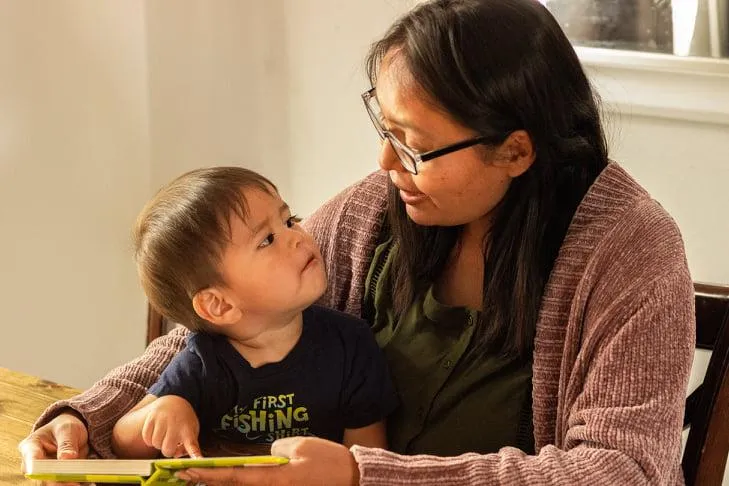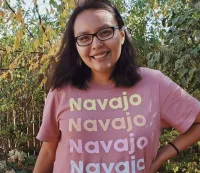
How To Read Navajo Bilingual Books (Easy Guide for Non-Fluent Parents)
So you want to help your child learn Navajo?
The best thing you can do is start reading books.
Many parents today are using books to teach their child another language, even as non-native speakers! So why not do it with our Navajo language? We live in a time where we have growing resources like bilingual books to help us (parents and caregivers) give our child exposure to our Diné language.
I didn’t know how possible it was until I started reading Navajo bilingual books with my kids.
Before that, I remember saying to myself, “How can I read Navajo to my kids? I can’t even speak Navajo.”
But I’ve been doing it and all I really needed was a little help from family and to trust the process along the way.
I’ll be honest, I’m not claiming that I read and speak Navajo like a pro (maybe one day soon). But what I am saying is that you can build your Navajo skills as you build your child’s.
It will take a few extra steps to get started but your child will greatly benefit from seeing how much you care about exposing them to their Native language.
And Good news! I have some great tips that will help you feel less intimidated like I once was! And I’m sharing my process to feeling more comfortable reading Navajo bilingual books and/or teaching Navajo through all books!
This post contains affiliate links, which means I may receive a small commission, at no extra cost to you, if you make a purchase using this link. Please see my disclosure for more details.

Table of Contents
Why books are so helpful in language learning
With books, the language learning possibilities are enormous.
Think about it. That’s how our generation learned to read and write English.
When I was a toddler, my mom would read to me and she said I would recite my favorite book -Cinderella – word-for-word!
It’s not just books that help us learn a language though. It’s stories.
I recited a whole book word-for-word because I remembered a story. Stories are memorable and powerful.
That’s why stories are popular in every language.
I believe we Diné kept our language through stories and gathering around the fire for many generations. . . until now.
I know there may be many factors to losing our language through the past years but I’m appreciative today that we finally have a written language and access to growing resources like Navajo bilingual books.
This means we have a greater chance to learn our language and teach our kids.
Did you know that many non-native speakers around the world are learning languages and teaching their kids other languages too? One of their helpful tactics is through reading bilingual books. Since they don’t speak the language directly in their home, they are using books to bridge the gap of language exposure and learning.
We can do the same and start exposing our kids to their Native language through books.
Books help kids make connections to the language through stories. They learn faster and grasp the language mechanics better.
When I started reading, I was amazed at how quickly my daughter started saying words and phrases on her own outside of reading!
Are you ready to see your child do the same?
Top 3 tips when reading for Navajo language learning
1. Be Consistent
Find time to read together. As a busy parent myself, I know it can be hard to stick to things but if you make it a part of a routine, it’s easier to stick with it.
For example, my daughter likes to read before bed so we usually read then.
I also find that my kids have become interested in books. They look at books often throughout the day so their interest helps motivate me to read to them.
At the very beginning of our Navajo journey, I found reading during lunchtime was a good time for us to read together.
Do what works best for you.
2. Ask a family member(s) to be a part of your child’s Navajo language growth
Many Dine families live with multiple family members or even generations of family in one household. And if you have at least one family member who’s fluent in the language, that’s a great opportunity for language learning.
I grew up with my aunts, uncles, and grandparents under one roof at some point in my childhood. I had so many opportunities but never learned either. I think we’ve gotten accustomed to speaking English more and more in the home because it was easier for parents to communicate with their kids and they wanted us to succeed in the modern world.
There are many factors that led to a decline of our language but we can turn that around and help our child learn in different ways and a couple of those ways is through books and family.
So how can family help?
Have your fluent family member(s) look at books with your child and talk about what they see. They can name things or what the characters are doing in Navajo.
Read with your fluent family member. Make it a fun family activity for everyone. Start with easy books meant for toddlers and work your way up.
Involving family helps the child make better connections to the language through family and culture.
3. Start with any book to teach Navajo!
I’ve talked about bilingual books being a great resource for Navajo learning and it is!
But I know not every family may be able to build a library of bilingual books right away. But the good news is that you start teaching Navajo with any book!
How?
By using the Navajo you already know, you can begin “reading” to your child in Navajo.
You probably already know a reasonable amount of Navajo words like people, animals, colors, etc. So just start with that! Then grab a familiar book you own and talk about what you see.
Now that you know where to start, you might be wondering what to do next.
I created for a step-by-step plan you can follow in reading to your child from day 1 and beyond. Think of it as a roadmap that will help guide you along the process.
Step-by-Step Roadmap to Reading Navajo With Your Child:
Start with a simple book where you already know Navajo words (think animal, people, and color books)
Learn new words(think description and actions) for books you already have
Translate books yourself. This may take extra effort but if you want to start learning Navajo yourself then teach your child, this is a good plan!
Check the library to see if they have Navajo bilingual books in your area. Then start reading!
Check out my list of Navajo bilingual book recommendations. My suggestion is to start with simple board books.
Work your way up to more advanced books as you begin to feel more comfortable with reading Navajo (see my strategy below to reading as a non-fluent parent).
With every step, be sure to read the same books often!
How do I even read Navajo books to my child if I’m not fluent?
Dine Bizaad is a new written language and not very many people can read it. It can be a hard language to learn to read but the great thing about it is when you learn the sounds of the letters you can begin to sound out the words with more ease.
It will be hard in the beginning but as a parent who can’t read Navajo or speak it fluently, you have options to make the process easier.
The first thing you should know is that there are some books with audio. And if it has audio, use it!
It will save you time and help both you and your child to start learning the language in a relaxed environment. We need to hear the language often so the more exposure from Native speakers, the better.
Next, some books are very simple. Usually one word or a simple phrase. And they are usually repetitive. This makes it super doable for anyone starting out! For a complete list of book recommendations, click here.
But even if the book uses simple Navajo words or longer phrases and sentences you don’t know, you’ll still need to figure out how to read it to your child.
As a parent that can’t speak Navajo fluently, I have created a strategy to reading to my child that makes the process easier and doable. And I’m happy to share it with you!
How to Read to Your Child as a Non-Fluent Parent:
Look at the book before reading it to your child.
See what words you already know.
Ask and audio record a family member on how to say the words you don’t know. (Recording helps if you forget or need more practice later so you don’t have to ask repetitively.)
Practice! (And keep the recording handy when it’s time to read to your child.)
Read the book with your child. (You may not be the best at your first reading but the more you read, the better you’ll get)
As always, read the book again and again. (Reading the same book more than once helps build language skills faster)
This is the strategy I usually take. The biggest gamechanger is recording the audio. I ask my mom and use my phone to record her so I can listen to the word repetitively and practice saying them on my own time.
It might take a few extra steps but you’ll be happy you did.
And guess what? I have my strategy ready for you to use at home in a free printable! Just print it out and when you are ready to read to you child, you know exactly what steps you need to take.
Where can I find Navajo bilingual books for my child?
Here are the top 2 places to purchase Navajo bilingual books:
Salina Bookshelf
Heritage Language Resource Center
To see all my book recommendations, check out Complete List of Navajo Books for Families.
It’s not a guarantee, but to get bilingual books for free, here are two ideas:
Go to the library and see if they have any Navajo bilingual books you can check out.
Tell family and friends you’re teaching your child Navajo and send them a gift wish list for your child’s birthday or Christmas.
Again, if you can’t get Navajo Bilingual books right now, start with what you have at home and with the Navajo words you already know. Then work on getting at least one book a month to slowly build your library.
Start using books to help your child learn Navajo!
Teaching Navajo with books is the best thing you can do to start the language learning process for your child. Most kids love books and stories and that starts the language learning process.
With my tips and strategies, I’ll hope you’ll take advantage of Navajo bilingual books and all books to help our children start learning their Native language today.
Any questions you still have on the topic? Comment below.
If you’ve found this article helpful, be sure to share!

Lintara C.
Lintara aka Ms Linturtle is a wife and mom to three kids. She's helping her family learn Navajo alongside her. She helps create resources and materials that other families or educators can use in their Navajo language learning and teaching!

